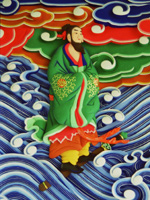

This hands-on healing technique is developed from the vast theoretical body of Traditional Chinese Medicine and makes use of almost the same meridian system and energy-points of Acupuncture (acupoints or Tsubos), but is performed without needles. It applies pressure to the body using thumbs, fingers, palms, elbows and knees, in order to restore balance to the flow of energy throughout the entire body of the recipient. The correct technique involves stretching and leverage to encourage greater flexibility and postural integrity. Most people can benefit from Shiatsu massage, from small children to the elderly.
From the Western point of view, shiatsu works directly to calm the autonomic nervous system and increase the body’s resistance to stress. Shiatsu helps to maintain and improve muscle tone through the release of toxins and deep seated tensions from the muscles. It promotes the healthy functioning of the internal organs and stimulates lymph and blood circulation. It can also help to balance the hormonal system. Sometimes the pleasurable release of endorphins can be experienced too. It is believed that shiatsu can also strengthen the immune system.
Regular and consistent shiatsu treatments can become an important aspect of preventive health care, as well as the treatment for existing symptoms.
The shiatsu recipient should be dressed in light comfortable clothing for treatment. Massage oils or lotions are rarely used or needed in treatment.
Keiraku (Meridian) and Zen Shiatsu
Zen Shiatsu follows the teachings of the late Shizuto Masunaga (1925-1981) of Japan, and combines traditional Eastern views with modern Western scientific understanding. Zen is a Japanese word meaning "meditation". Shiatsu acquired its name with the publication of Tenpaku Tamai's book Shiatsu Ho (Shiatsu Method) in 1919.
Masunaga presented 12 meridians, corresponding to the 12 basic organ-affiliated meridians of the Chinese system. The meridian pathways are similar to, but not the same as, the Chinese ones. The main difference is an extension of each meridian to cover the legs to arms while passing through the associated diagnostic region of the abdomen.
The nature of the energy flow is analysed on the basis of the Chinese conception of the duality Yin and Yang, explained in two states called Kyo and Jitsu. In the Kyo state, the flow of Ki (or Chi) is sluggish, and the body functions are dulled. In the Jitsu state, the flow is to rapid, and the body functions are overactive.
The unique quality of Shiatsu is that it emphasizes efficient bodily movement and leads to the perception from one's true physical and spiritual centre. This increased awareness of the self leads to a healthier being and greater independence in health matters.
It must be remembered that, in many parts of the world, some form of massage still forms an important part of the local folk medicine. These are medical traditions which have been practiced effectively for centuries.
